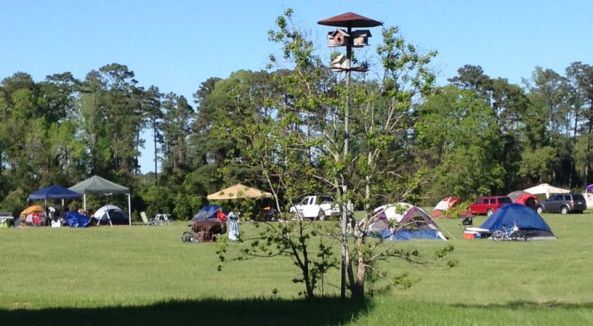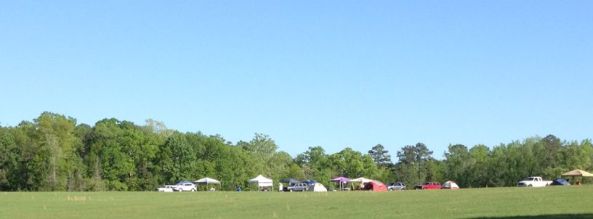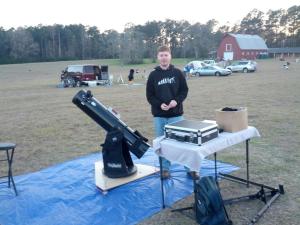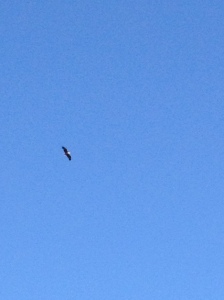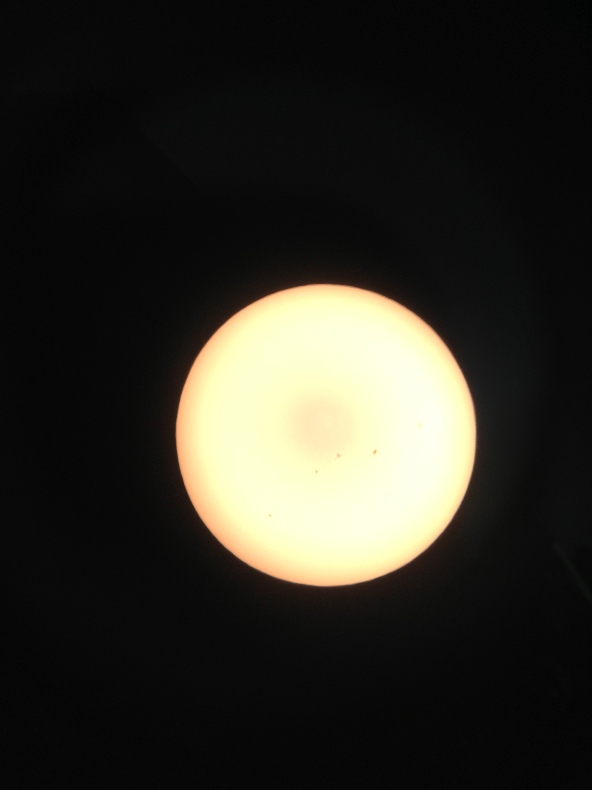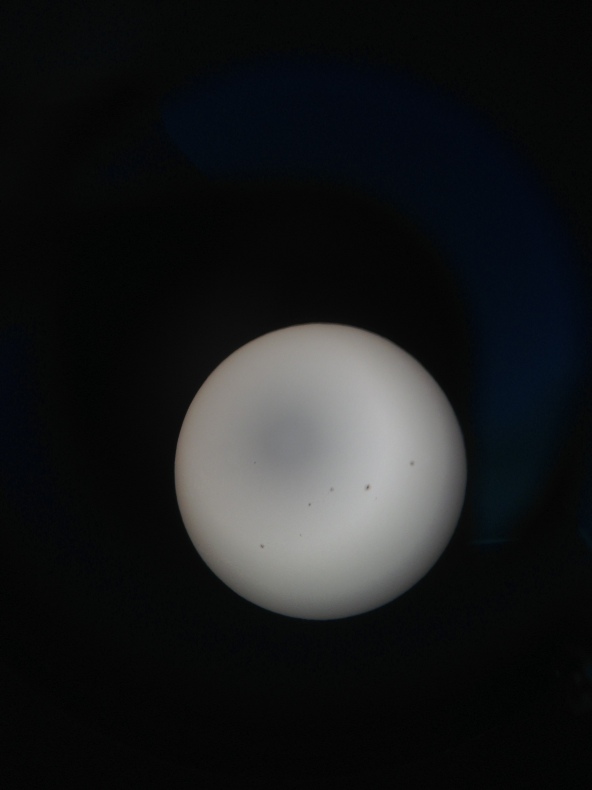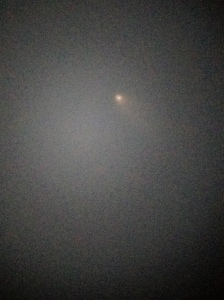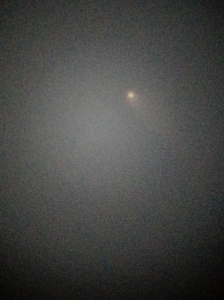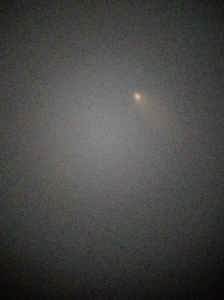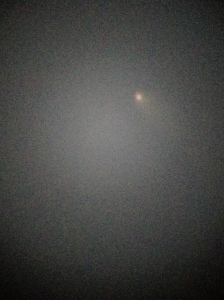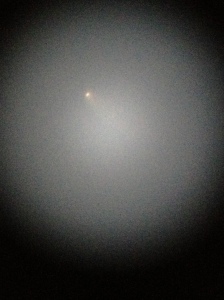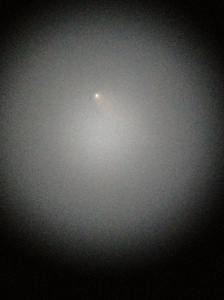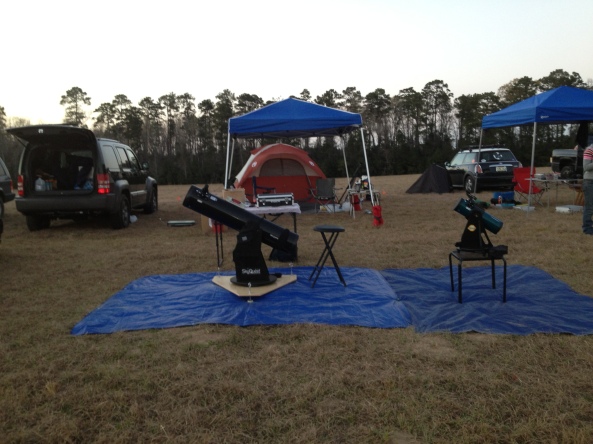Day 3: March 23, 2012

This was my last day at the star party and after the previous night, I had no idea what I wanted to see and I was worried about dew. I sat around all day in my tent thinking about what I wanted to see before 2am, but then I began my frantic search for something I could use as a makeshift dew shield. I had two shoe strings packed away just in case I would need something to tie down anything related to the tent. I had my 7’x2′ camping mat I had been sleeping on under my sleeping bag. I rolled up the mat and tied it down. It fit the end of my telescope just fine and it was snug enough to hold. I only had to worry about weight and any interference with my visual experience.
I viewed the night sky in my XT8 until 4:30 in the morning, so the makeshift dew shield worked perfectly. As I said in my recap of Day 2, I ended up seeing two more shooting stars with my telescope and probably six or seven others with my naked eyes over the course of this night.
So about night #3…
My other camping buddy from Mississippi told me about someone who had Shreveport star club experience and that guy just happened to roll in that afternoon. I introduced myself and found out a bit about the SBAS, as well as his nifty self made 12″ telescope. If I remember his story correctly, this telescope was someone else’s project and that man passed away, so Joey took up the task of finishing the job.

I had a new neighbor come in that night as well. I came to find out his name was Dave out of New Orleans. Fantastic fellow. Great setup. The only thing was. It took him about three hours to calibrate his telescope. Like he said to us, he earned it. After all these years of doing the hard work of searching, he deserves equipment that takes the work out of the equation.
The stargazing started the same way as previous nights with the arrival of Jupiter and Venus. Jupiter came up shortly after Venus, so I viewed it for a while until I got bored. I tried looking at Venus while the new neighbor was setting up his elaborate telescope on a heavy duty tripod. The guy with the Z10 had the same Zhumell filter set, so I let him know the variable polarizer was helping smooth out Venus. From there, I waited for things to get dark. I tried finding Comet Garradd, but the sky was still a tad too blue for looking at fuzzies like that. I went back to looking at Jupiter and then glanced at Jupiter through the custom 12″ scope Joey brought down. I spent some time going between an 80A filter and a variable polarizer on Jupiter, but the image was really not all that different from what I see here in Shreveport.
Mars & minor calibration
I swung my scope around to Mars and tried picking out some surface features. I could see the polar cap and one of the mares, but everything was still a little too bright for me to really get anything out of the view. I ended up using Mars to help fine tune the nut on the base of my telescope for controlling my side to side movement. Mars was great because it’s a smaller planet in my telescope and its time inside my viewing field is often very short.
Bode & Cigar
The sky was still not dark enough in my opinion to give M95/M96 a go, so I went in search of other galaxies. By then, things were darker near Ursa Major. I spent a little bit of time finding the comet again and from there, hopped on over to M81 and M82, Bode & Cigar. I fit them into one view and had a look at them in Joey’s scope as well. I thought I could fit them both in my 17″ eyepiece (Didn’t I do that before?), but that was entirely too much power for the task, so I backed off to my 25mm and sat there to enjoy the view.
M95, M96, & a supernova
I went back to look for M95 and M96 after that. I really wanted to see the supernova in M95, but I was worried 95 would be dim just like here in Shreveport. From Mars, I bounced around and found 95 and 96 within seconds. I found 96 first, actually. I remembered that the last time I found these two, M95 was above 96, so I shimmied a short distance and saw it right away. I stared at it with my 32mm eyepiece and dropped down to my 17mm, as I often do. I saw a dot and so I walked down to ask Steve if I was on it. From what he said, it sounded like I was looking on the correct side of M95’s core, so consider SN2012aw found. I went back to M96 for a short while and then went looking for the other nearby pair of galaxies, M105 and NGC 3384. Found both of them right away. For some reason, I really enjoy finding those two more than 95 and 96.
M13, The Great Cluster in Hercules
I walked around for a while after that, checking out views in Joey’s 12″ scope and talking shop with a few others. I watched Dave work on his calibration and shot the breeze with him at the same time. While I was at the 12″ telescope, I mentioned looking for where Hercules was in the sky. I couldn’t make out the top two stars amidst all the extra clutter. Once Joey pointed it out, we actually decided to chase after M13 and while we were at it, we looked at a small galaxy below M13. I had no idea a galaxy was even there. When I climbed up the ladder to look through the eyepiece of that 12″, I had to ask where the galaxy was, but as soon as he said it, I saw NGC 6207 underneath two stars. It was a very small galaxy that wasn’t very bright at all, but no averted vision was required to find it.
Sharing M3, M13, & M51
Also while I was walking around, newcomers and students were roaming around, looking through telescopes. I had no idea people would be doing that on Friday night, but since I realized I had left my own telescope unattended, I decided to hurry back to make sure all of my eyepieces were still there. I also ran into two of these visitors checking out open clusters in the 12″ scope, so globular clusters were brought up and I offered to pull up M53 since I was just getting ready to roam around Coma Berenices. I backpedaled and said I could find M3 for them.
Once I put my scope on M3, I walked back over to find this pair of enthusiastic onlookers and mentioned I had found M3. I loosely explained what a globular cluster looked like to them and how I tended to use averted vision to help see the detail in the center. I also happened to briefly mention Omega Centauri, but when they both looked through my XT8 at M13, I realized I was more than happy to have been the one to help show them something they had never seen before. I then asked if they had seen any galaxies yet and since their answers were No, I went after M51 with its companion and wowed them again. As an afterthought, I probably should’ve put them on M81 and M82. I also think I showed them Comet Garradd. While I was showing them these things, I explained how I had only recently returned to astronomy and that the XT8 was a great beginner telescope.
M104: The Sombrero Galaxy
I hadn’t chased after M104 yet and because it wasn’t one I had seen before, I took the time to glance at a chart to locate this particular fuzzy object. I turned around and looked up to find those four stars in Corvus and drew a diagonal line up to where the Sombrero galaxy should be. It took me a little while, but I finally hovered over it. At low power, the dark line did not show up, but from 17mm on down, it was apparent. There was a line of stars near M104 that formed a right angle with another line of stars and I found this particular arrangement interesting to the point where I assumed it had a name or a catalog number, but from what I can tell, it does not. I’m not even sure if it is considered an asterism.

(Image taken from SkySafari 3.1.1 Pro for iPhone)
The Cat’s Eye Nebula
The next object I chased after was one I have tried looking for at home, the Cat’s Eye Nebula (NGC 6543 ). If you’re not familiar with this object, it is located in Draco and sits between two of the bends in the constellation. Over the past month or so, Draco has been getting higher and higher in the sky, allowing objects like this to escape any sort of low horizon glow. I mentioned the object to Dave and then went about finding it on my own. I used low power first, scanning for something that didn’t look like a star anywhere near other stars. I ended up finding something bright and took it down to 6mm. It seemed to have tapered edges, much like how an outline of the eye might have. Unfortunately, it did not have the nice halo I was accustomed to viewing on the Eskimo Nebula and pictures of the Cat’s Eye on the internet.
The inner portion of the object was very bright and I could just barely make out a much brighter center, ultimately forming the overall picture of what might resemble an eye. I was still unsure about whether or not I had found the object, so I consulted Leon and Joey. We located it on a star map and then put the 12″ on it. They were able to find something, so I had a look and agreed that the object they had in the 12″ was in fact the object I had just seen. Eventually, Dave put his calibrated scope on this one and when I came over, he said that he didn’t see anything that looked like anything at all. I climbed up the ladder to have a look and immediately saw the planetary nebula at almost dead center in his 40 something millimeter eyepiece. He had noticed the bright spot and wondered if that was it. He later looked it up on the internet with his mobile connection and agreed that it was a very cool object.
I noticed the seat on my observing stool was getting damp, so I pulled out my makeshift dew shield I made out of my camping mat, put it on my telescope and went back to viewing the night sky.
Saturn
Saturn was high in the sky and I heard Joey yell out that Saturn looked amazing, so I put my telescope right on it and had a look. Yes, it was absolutely amazing. It was also turned on end and the rings were straight up and down, although not on plane. I pulled out my #12 yellow and had a look. It had contrast, but I couldn’t see Cassini. I pulled out a #58A and had the same impression. My theory was that if I stacked the two, I could reproduce the effects of a #11 yellow-green. Once I stacked them, I could easily make out the Cassini Division at the two ends of the rings. Very neat. Honestly, Saturn was crisp and a real treat over the entire course of the star party.
Clusters in the East
I spent a fair amount of time wandering around in the eastern sky, meandering through open clusters I didn’t feel like identifying. I backed off and went for some globular clusters in the southeast because Antares had risen above the tree line. I knew I could find M4 and M80 right away. I then looked for M107 higher up. Then I went looking for M10 and M12, but I never found either one. I had trouble finding both of those when I was here in Shreveport, but oddly enough, I’ve stumbled onto both in party cloudy skies, so figure that out. I have no idea why those two are such problems for me. Anyway, I ended up finding M14 and two other globs that had a very blue hue to them low in the sky. I’m not sure if those were M19 and M62, but I think the two I found were further to the north than that. Looking at a star map, they could have easily been M69 and M70. I’ll have to revisit this area to really know for sure.
2am was fast approaching and I was still dew-free with my handy dandy shield. I was waiting for two things to happen. I wanted Centaurus to show up so I could see Omega Centauri. I wanted Sagittarius to rise above the trees so I could find all those nebulae and clusters down in there.
Centaurus, Omega Centauri, & Centaurus A galaxy
Centaurus was indeed rising above the trees, so I let a few people know it was there and started looking for Omega Centauri. I had seen it the previous night in two other telescopes, but since mine had a dewed-over secondary mirror, I couldn’t give it a go. Luckily, I hadn’t been hit by dew yet, so I went for it. I thought I could barely see it low in the sky, so I went looking and found it just above the tree line. I also noticed a funny alignment of stars that zig zagged back and forth next to each other. Like the group of stars near M104, I assumed these weren’t named or numbered either. I went back to looking at Omega Centauri for a while longer. Leon came over to have a look since he missed it the night before and after that, asked about a galaxy over in that area. I ended up finding Centaurus A, the Hamburger Galaxy. At first, I couldn’t see the black line running down the middle, but once it rose higher in the sky, I could just barely make out the division. Neat, but not fantastic.
Roaming Sagittarius
Once Sagittarius came up, I swung my telescope over and because the Milky Way fluff was also lurking in that area low on the horizon, I could just barely see nebulosity in Trifid and Lagoon. I had to wait some more.
Trifid looked nice, but not spectacular. Lagoon looked nice as well. I went looking for the Omega (Swan) Nebula and the Eagle Nebula. For me, the Swan looks more like a backwards lowercase h, but I still love finding it. The Eagle was less impressive in my scope and I was certain my filters were a tad dewy, so I looked at that one with Steve’s scope along with a narrowband filter. It had some great nebulosity with that filter, but without it, was unimpressive.
I bounced around some more and found M22, so I shared that with Steve and an outstanding helpful guy named Will. M22 had some really great central stars for a globular cluster. Great cluster.
I found the Butterfly Cluster and Ptolemy’s Cluster, but I couldn’t see the galaxy that was on the edge of Ptolemy. Not sure why. It must come and go.
By then, the Milky Way was just outstanding, spanning across the sky. Of course, I’m sure in even darker skies, it would’ve been even more impressive, but for me, it was just awesome to be able to see it for a change.
I also ventured into a large spread of stars, a large open cluster of some kind, that had a round area of nebulosity inside of it. At first, I wondered if it was just a distant open cluster like what I had found near M35. After looking on the internet just now, the open cluster was the Sagittarius Cluster, M24, and the nebulosity inside of it must have been NGC 6603.
http://en.wikipedia.org/wiki/Sagittarius_Star_Cloud
The dew never touched me that morning and I hopped into my tent around 4:30am after shooting the breeze with a couple of guys on the other end who were working through Messier binoc and double star challenges.
New finds:
NGC 6207
SN2012aw
M104
NGC 6543 – Cat’s Eye Nebula
Cassini Division in Saturn’s rings
NGC 5128 – Centaurus A
Milky Way arched across the eastern sky
M24
NGC 6603


